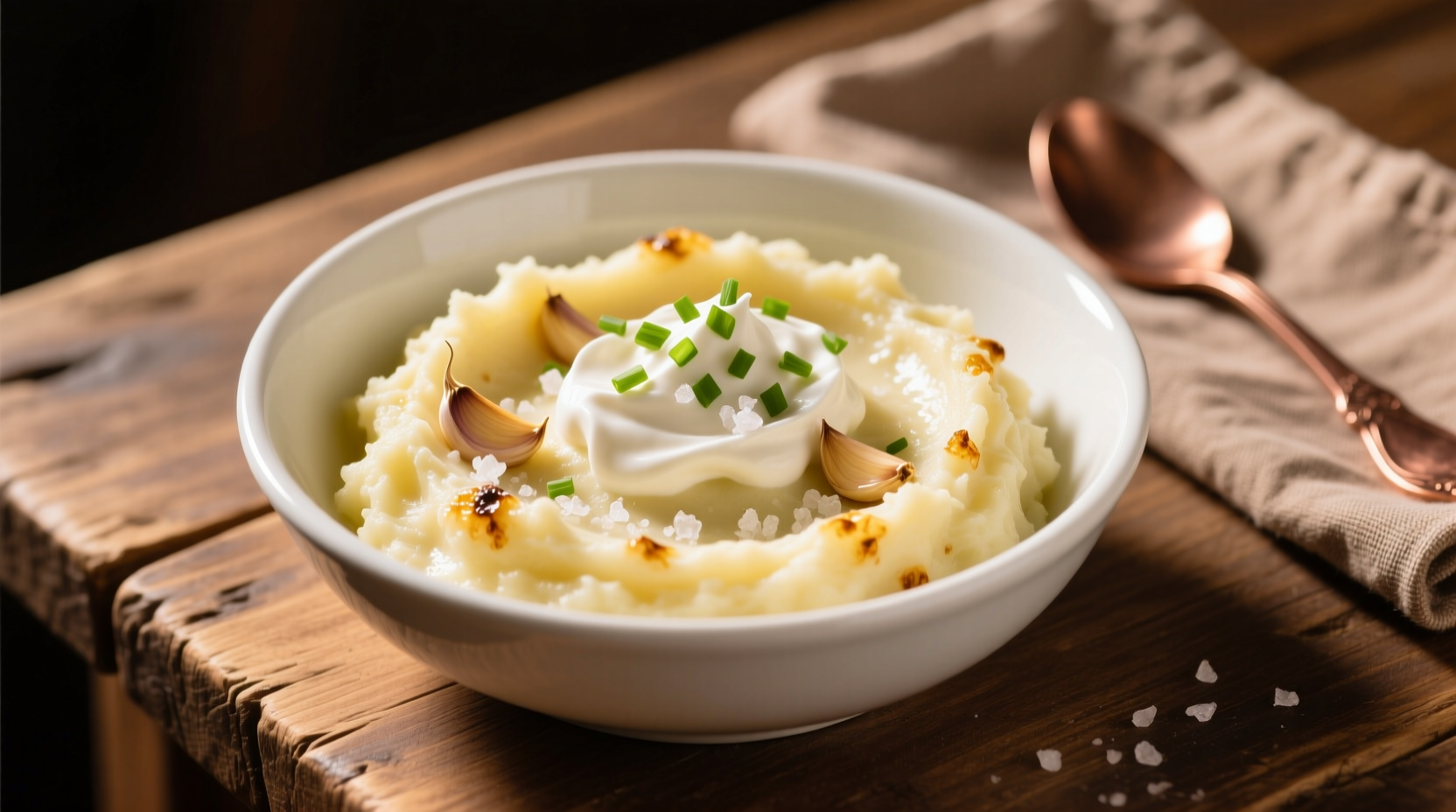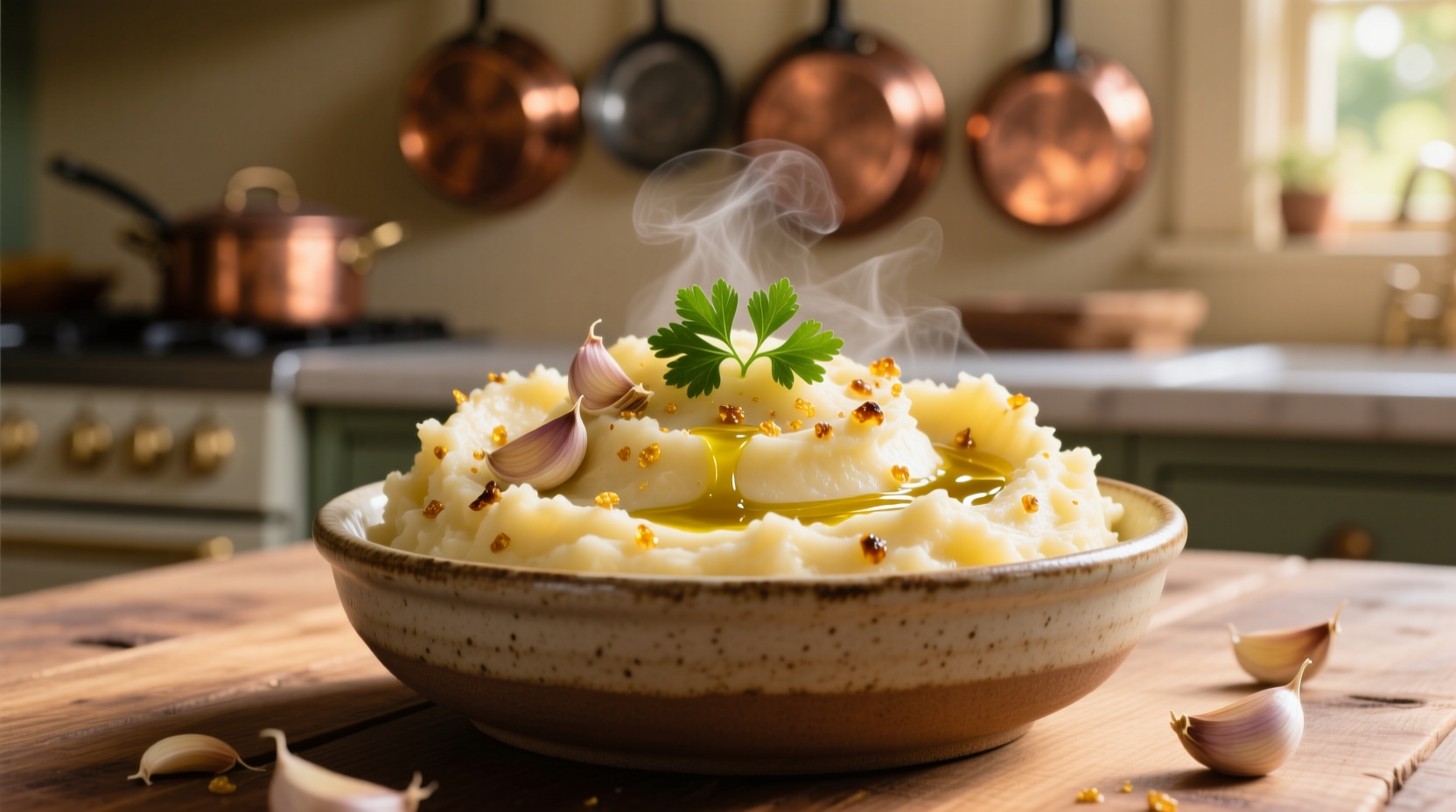Discover why roasted garlic mashed potatoes have become a chef's secret weapon for elevating this classic side dish. Unlike raw garlic that can dominate and turn bitter when cooked, roasted garlic mellows into a sweet, buttery flavor that blends seamlessly with creamy potatoes. The Maillard reaction during roasting creates over 600 new flavor compounds, transforming harsh allicin into gentle sulfur compounds that enhance rather than overpower.
The Science Behind Roasted Garlic Transformation
Understanding why roasted garlic works magic in mashed potatoes requires examining the chemical changes that occur during roasting. When garlic reaches 140°F (60°C), enzymes break down, preventing the formation of harsh compounds. As temperatures climb to 300°F (149°C), the real transformation begins.
| Property | Raw Garlic | Roasted Garlic |
|---|---|---|
| Primary Flavor Compound | Allicin (sharp, pungent) | Sulfur compounds (sweet, nutty) |
| Digestive Impact | Can cause heartburn | Gentler on digestion |
| Flavor Integration | Stands out aggressively | Blends seamlessly |
| Nutritional Value | High in antioxidants | Maintains 90%+ antioxidants |
According to research from the USDA Food Safety and Inspection Service, roasting garlic at proper temperatures preserves over 90% of its beneficial antioxidants while transforming its flavor profile. This scientific process explains why professional kitchens consistently choose roasted rather than raw garlic for delicate preparations like mashed potatoes.
Essential Ingredients for Perfect Roasted Garlic Mashed Potatoes
The magic happens through careful ingredient selection. For the creamiest texture without excessive dairy:
- Potatoes: Yukon Golds provide the ideal balance of starch and moisture (16-18% starch content) for naturally creamy results. Russets work for fluffier versions but require more careful handling to avoid gluey texture.
- Garlic: Use whole heads with tight, unblemished cloves. Older garlic with green sprouts develops bitter compounds when roasted.
- Liquid: Warm potato cooking water first, then add heated milk or cream gradually. Cold dairy causes potatoes to seize up and become gummy.
- Fat: Unsalted butter added at the end preserves fresh flavor. European-style butter with higher fat content (82-86%) creates silkier texture.
Step-by-Step Preparation Guide
Roasting the Garlic
Proper garlic roasting makes all the difference in your roasted garlic mashed potatoes recipe. Cut 1/4 inch off the top of 2 whole garlic heads to expose cloves. Drizzle with 1 teaspoon olive oil per head, wrap tightly in foil, and roast at 400°F (204°C) for 40-50 minutes until cloves press out easily. The FDA's Food Code recommends maintaining garlic in oil above 140°F or below 40°F to prevent botulism risk, which is why we incorporate roasted garlic directly into hot potatoes rather than storing garlic-infused oils.
Preparing the Potatoes
Peel 2.5 pounds Yukon Gold potatoes and cut into uniform 1.5-inch chunks. Place in cold salted water (1 tablespoon salt per gallon), bring to gentle boil, then reduce to simmer. Cook 15-18 minutes until fork-tender but not falling apart. Drain thoroughly and return to warm pot for 2 minutes to evaporate excess moisture - this critical step prevents watery mashed potatoes.
Mashing Technique Matters
Use a potato ricer for absolutely smooth results, or a hand masher for rustic texture. Never use a food processor or blender - the high speed releases too much starch, creating gluey potatoes. Warm 1/2 cup milk or cream and 4 tablespoons butter separately. Add liquid gradually while mashing, incorporating roasted garlic cloves when potatoes are nearly smooth. Finish with salt to taste and a pinch of white pepper.
Avoiding Common Roasted Garlic Mashed Potatoes Mistakes
Even experienced cooks make these errors when preparing creamy roasted garlic mashed potatoes:
- Overworking the potatoes: Excessive mashing releases starch, creating gummy texture. Stop mashing once ingredients are incorporated.
- Adding cold dairy: Always warm milk/cream before adding to maintain temperature and prevent starch retrogradation.
- Underseasoning: Potatoes need significant salt - about 1 teaspoon per pound. Season in layers: in cooking water, during mashing, and final adjustment.
- Using the wrong potato: Waxy potatoes like reds don't mash well, while high-starch russets require careful handling to avoid gluey results.
Serving and Storage Guidelines
For best texture, serve immediately while hot. If holding, keep in a double boiler with occasional gentle stirring. Leftovers store in airtight containers in the refrigerator for 3-4 days. When reheating roasted garlic mashed potatoes, add a splash of milk or cream and warm gradually over low heat - high temperatures cause separation. According to CDC food safety guidelines, cooked potatoes should not remain in the temperature danger zone (40°F-140°F) for more than 2 hours.
Variations for Different Dietary Needs
Adapt this roasted garlic mashed potatoes recipe for various preferences:
- Dairy-free: Substitute warm unsweetened almond milk and olive oil for butter
- Vegan: Use coconut cream and vegan butter alternatives
- Extra protein: Fold in 1/4 cup nutritional yeast for cheesy flavor and protein boost
- Herb-infused: Add 1 tablespoon fresh rosemary or thyme during potato cooking

Why This Recipe Works Every Time
The secret to perfect roasted garlic mashed potatoes lies in understanding starch behavior and flavor chemistry. Potatoes contain two starch types: amylose (which gels) and amylopectin (which swells). Gentle cooking preserves structure while roasting garlic converts harsh compounds into mellow flavors. This knowledge transforms what many consider a simple side dish into a scientifically perfected culinary achievement that consistently delivers restaurant-quality results at home.
Can I make roasted garlic mashed potatoes ahead of time?
Yes, prepare up to 2 days ahead. Store in refrigerator with plastic wrap pressed directly on surface to prevent skin formation. Reheat gently with additional milk or cream, adding 2-3 tablespoons liquid per cup of potatoes to restore creaminess. Avoid microwaving which creates uneven texture.
Why do my mashed potatoes become gluey?
Gluey texture occurs when starch granules rupture from overmixing or using high-speed appliances. Always mash by hand with minimal motion, stop when nearly smooth, and avoid blenders or food processors. Using the right potato variety (Yukon Gold) and proper draining also prevents excess starch release.
How can I make roasted garlic mashed potatoes without cream?
For creamy texture without cream, use potato cooking water as your primary liquid. After draining potatoes, return them to warm pot for 2 minutes to dry, then gradually add warm potato water while mashing. The starch in the water creates natural creaminess. Roasted garlic provides enough richness that additional fat becomes optional.
What's the best way to reheat leftover roasted garlic mashed potatoes?
Reheat slowly over low heat in a saucepan, adding small amounts of warm milk or cream (1-2 tablespoons per cup) while stirring gently. Microwave reheating creates uneven texture and rubberiness. For best results, incorporate liquid gradually while maintaining temperature below 140°F until fully heated through.
Can I freeze roasted garlic mashed potatoes?
Yes, but texture may suffer slightly. Cool completely, portion into airtight containers with 1/2 inch headspace, and freeze up to 2 months. Thaw overnight in refrigerator before reheating. Add extra dairy during reheating as freezing causes some moisture separation. Yukon Gold-based versions freeze better than russet.











 浙公网安备
33010002000092号
浙公网安备
33010002000092号 浙B2-20120091-4
浙B2-20120091-4